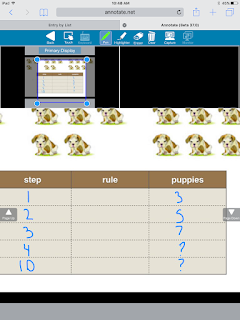This week's assignment was a fun one. You know when you are planning to be observed by your administrator, you try to pull out all the bells and whistles and show how awesome you are? I thought about going into this week doing the same thing, but decided against it. Here's day two of a "regular" lesson during first period after a snowy start to the day. Needless to say, the kids were amped.
The topic of the week is data analysis and scatterplots. We started the day before doing Yummy Math's Opening Weekend activity and plotted the points for all of the movies. Great conversations about noticing and plotting points when given this table:
Some highlites included: there are 18 movies, that's a lot of money(!), there is no total gross for Star Wars, and the movies range from 2006 to 2015. Some fun facts: more than half of the class has not seen the new or any Star Wars movies (gasp!) and one student had the most of seeing 16 of the above movies. When told to plot the points, the kids had lots of questions about how to plot such large numbers. They were concerned with being precise which resulted into rounding and estimation. Here's what our graph looked like:

We talked about how there's a positive and linear association. This then lead into drawing line of best fit. I asked the class what it looks like and a student responded that it's a line on the graph. I replied, "Oh, like this?"

Student: "No! It needs to be in the middle of the dots with some above and some below. It has to go up!"
Me: "Right. Go ahead, everyone, and do that. Draw your line of best fit"
As I walked around the room checking in with the students, too many of them had what I drew on the board!! This goes back to the idea of last week's post on learned helplessless. No matter what I do with turning and talking, noticing and wondering, etc. it's very difficult to keep all students engaged. Those that wake up from day dreaming see something on the board and think they need to copy it ad nauseam. They all didn't know why the drew it on their sheet when I talked with them. It's very frustrating when you think everything is going well and all kids are engaged and then you see this on their sheet. We reconvened as a group and made sure no one had what I drew on the board and continued on our way.
The kids did great as we made numerous conjectures and, I think, by the end all got something out of the activity.
My favorite part was closing and seeing if our prediction on Star Wars lifetime gross was getting close. Here's what we found:

This is the excitement that you love to see. The students went nuts to see how high it is already. We graphed it to see what it looks like:

"That's an outlier!" they shouted. It led to more discussion on what to do with outliers and how they should be treated. Some were mad that they didn't get the "correct" answer. That made me happy because it kicked in how math should be treated and the answers aren't always what they're supposed to be. It's all about the process and thinking like a mathematician. I look forward to doing more activities where we can work on the process and not focus on being correct or copying everything that is written on the board!













